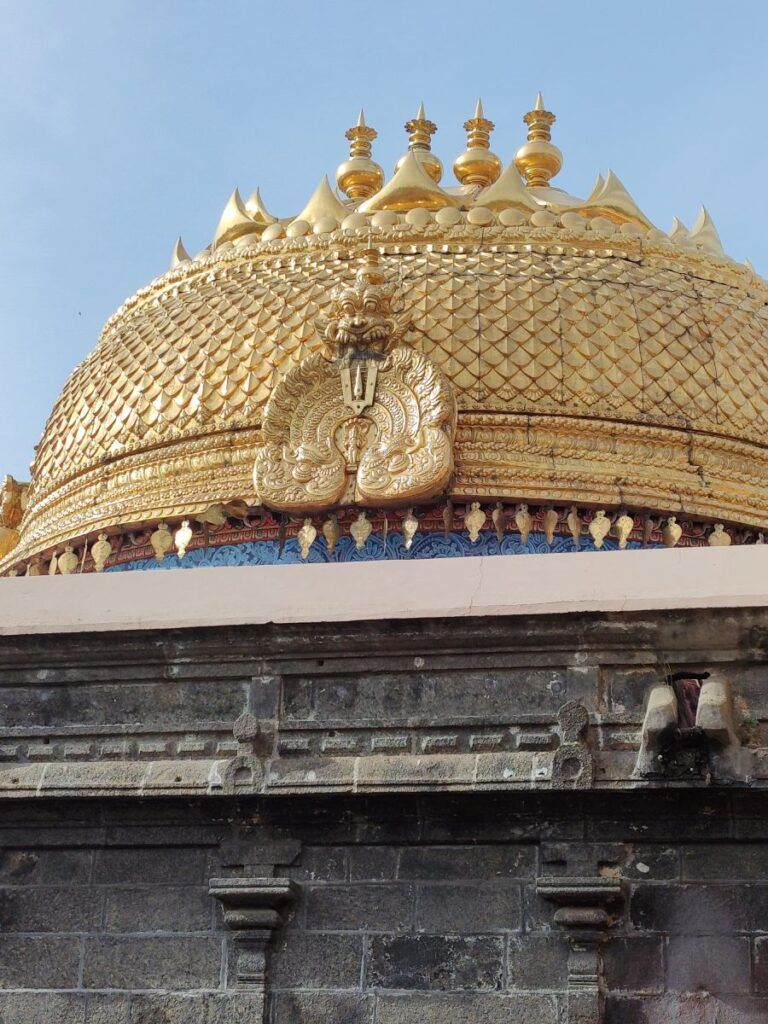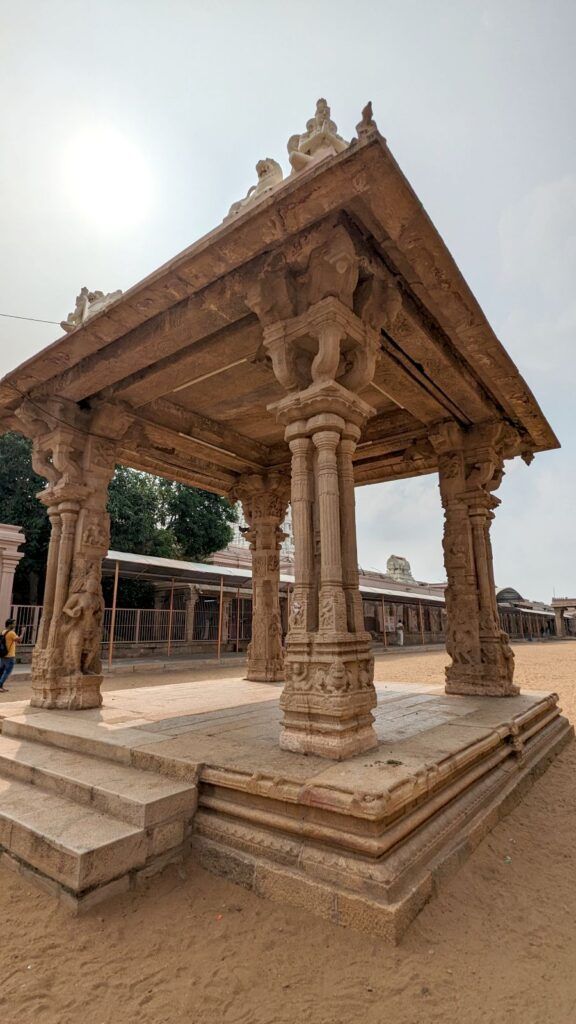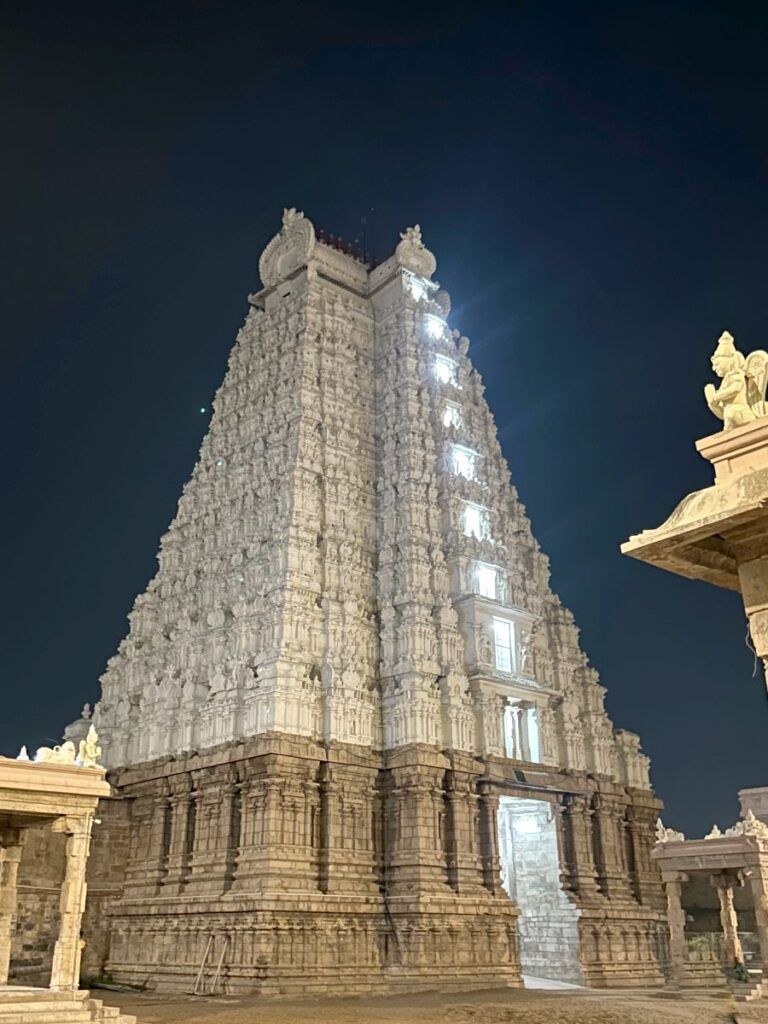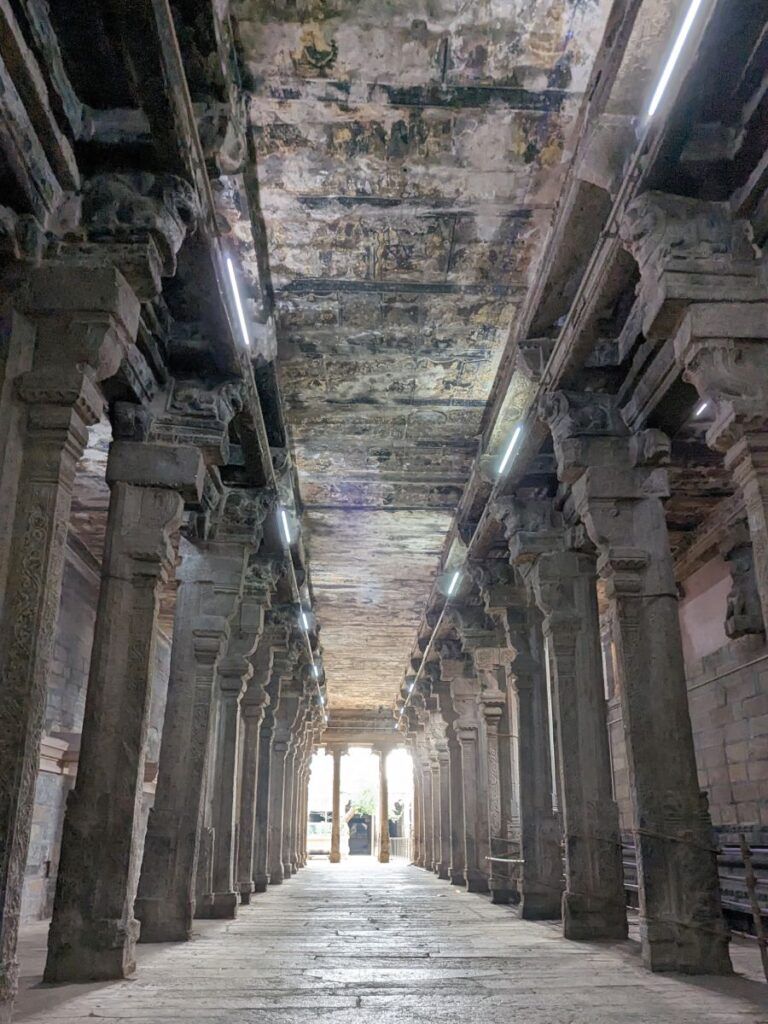Ranganathaswamy Temple Srirangam
The Srirangam Ranganathaswamy Temple is a Hindu temple dedicated to Ranganatha, a form of the god Vishnu. It is located in Srirangam, Tiruchirappalli, Tamil Nadu, India. It is one of the most important Vaishnavite temples in the world and the largest functioning Hindu temple in the world.

Contents
- 1 History of Ranganathaswamy Temple, Srirangam:
- 2 Legend of Srirangam Ranganathaswamy Temple:
- 3 Significance of Srirangam Ranganathaswamy Temple:
- 4 Myths of Srirangam Ranganathaswamy Temple:
- 5 Architecture of Ranganathaswamy Temple:
- 6 Specialties of the Sri Ranganathaswamy Temple:
- 7 Ranganathaswamy Temple Timings:
- 8 Places to visit near Srirangam Temple:
- 9 FAQ:
- 9.0.1 Q: What is the significance of the Srirangam Ranganathaswamy Temple?
- 9.0.2 Q: What is the history of the temple?
- 9.0.3 Q: What is the presiding deity of the temple?
- 9.0.4 Q: What are the darshan timings of the temple?
- 9.0.5 Q: What are the different types of darshan available?
- 9.0.6 Q: What is the dress code for visiting the temple?
- 9.0.7 Q: What are the facilities available at the temple?
- 9.0.8 Q: What are the festivals celebrated at the temple?
- 10 How to reach Ranganathaswamy Temple:
- 11 Google Maps:
History of Ranganathaswamy Temple, Srirangam:
Srirangam temple is one of the largest religious complexes in the world, and is the largest Hindu temple complex. It is also one of the 108 Divya Desams, the most sacred pilgrimage sites for Vaishnavites.
The history of the Ranganathaswamy Temple is long and complex, dating back to at least the 2nd century BCE. The srirangam temple is mentioned in the Tamil Sangam literature, and is also mentioned in the works of the Alvars, the Vaishnavite saints who lived between the 6th and 9th centuries CE.
Srirangam temple was initially a small shrine, but it grew in importance and size over the centuries. The Chola kings (9th-13th centuries CE) were major patrons of the temple, and they built many of the structures that are still standing today. The temple was also patronized by the Vijayanagara Empire (14th-17th centuries CE), and the Nayak dynasty (16th-18th centuries CE).
The temple has been invaded and damaged several times over the centuries, by Muslim invaders and by European colonial powers. However, the temple has always been rebuilt and restored, and it remains one of the most important and active Hindu temples in the world today.
Read More>> Kanipakam Varasiddhi Vinayaka Swamy
Legend of Srirangam Ranganathaswamy Temple:
According to Hindu legend, the Srirangam Ranganathaswamy Temple is the site where Lord Vishnu first appeared to the sage Vibhishana, the brother of the demon king Ravana. Vibhishana had surrendered to Lord Vishnu during the Ramayana war, and Lord Vishnu had promised to grant him a boon. Vibhishana asked for a visible manifestation of Lord Vishnu to worship, and Lord Vishnu appeared to him in the form of a reclining deity on the banks of the Kaveri River.
Vibhishana wanted to take the image of Lord Vishnu back to Lanka with him, but Lord Vishnu told him that the image was too heavy to be moved. He also told Vibhishana that the image was meant to stay in Srirangam, where it would be worshipped by devotees from all over the world.
Another legend associated with the Srirangam Ranganathaswamy Temple is that the sage Gautama Rishi performed severe penance in this place in order to view Maha Vishnu in reclining position. Lord Vishnu appeared to Gautama Rishi as Ranganathaswamy, and Gautama Rishi asked him to stay there forever so that devotees could worship him in the ages to come.
The Srirangam Ranganathaswamy Temple is one of the most important Hindu pilgrimage sites in the world. It is also one of the largest functioning temples in the world, covering an area of over 156 acres. The srirangam temple complex is home to over 108 shrines, 39 mandapams (halls), and 12 sacred water reservoirs.
Read More>> Shree Somnath Jyotirling Temple: The Shrine of Eternal Light

Significance of Srirangam Ranganathaswamy Temple:
The significance of the Srirangam Ranganathaswamy Temple is manifold. It is:
- One of the most important Hindu temples in the world. It is the foremost among the 108 Divya Desams, which are the most sacred Vishnu temples in the Vaishnava tradition.
- A masterpiece of Dravidian architecture. It is the largest functioning Hindu temple in the world, with a massive complex that covers over 600 acres. Srirangam temple is adorned with intricate carvings and sculptures, and its seven concentric enclosures are a unique feature.
- A major center of pilgrimage and tourism. Millions of people visit the temple each year to worship Lord Ranganatha, the reclining form of Vishnu. The temple is also a popular tourist destination, known for its stunning architecture and rich cultural heritage.
- A significant archaeological and epigraphical site. The Srirangam temple complex contains numerous inscriptions that provide insights into the early and medieval South Indian society and culture.
- A major economic and charitable institution. The temple has a long history of providing social services to the community, including operating a free kitchen, running educational and hospital facilities, and financing regional infrastructure projects.
Read More>> Trimbakeshwar Jyotirlinga Temple
Myths of Srirangam Ranganathaswamy Temple:
The Ranganathaswamy Temple is one of the most sacred Hindu temples in the world, and its origins are steeped in myth and legend. Here are some of the most popular myths associated with the temple:
- The origin of the temple: According to one legend, the srirangam temple was created by Brahma himself, who was performing austerities during the Samudra Manthana (churning of the cosmic ocean). The Srirangam Vimanam (the temple’s central shrine) emerged from the ocean as a result of Brahma’s penance. It remained in Satyaloka for ages, before being brought to Ayodhya by King Ikshvaku. After Rama, an avatar of Vishnu, had killed the evil demon Ravana, he gave it to King Vibhishana who wanted to be with Rama. Vibhishana was carrying the shrine back to Sri Lanka on his head when he rested briefly at Srirangam. The shrine then got rooted there, and Sri Ranganathaswamy appeared before Vibhishana and said that he wished to stay on the banks of the Kaveri River.
- The curse of the Sanakas: Another legend tells the story of the Sanakas, four child sages who came to Srirangam for a darshana (vision) of Ranganatha. They were stopped by Jaya and Vijaya, the guardians of Vaikuntha (Vishnu’s heavenly abode). Jaya and Vijaya refused to let the Sanakas enter srirangam temple, even though the Sanakas pleaded with them. In anger, the Sanakas cursed Jaya and Vijaya to be born as demons opposing Vishnu in three births or good human beings in the following seven births. Jaya and Vijaya approached Vishnu and told him about the curse. Vishnu said that he would not be able to revert the curse, but he gave them the option to choose their own fate. Jaya and Vijaya chose to be born as demons, so that they could be killed by Vishnu and attain salvation.
- The secret passage: There is a popular belief that there is a secret passage connecting the Srirangam Ranganathaswamy Temple to the Tirupati Balaji Temple, another major Hindu temple in South India. This passage is said to be used by Vishnu to travel between the two temples. However, there is no concrete evidence to support this claim.
Read More>> Bhadrachalam Temple | Bhadradri Seetha Ramachandra Swamy

Architecture of Ranganathaswamy Temple:
The temple’s architecture is a splendid example of Dravidian architecture and is renowned for its grandeur and intricate details.
Here are some key architectural features of the Sri Ranganathaswamy Temple:
Gopurams (Pyramidal Gateways): The srirangam temple complex is enclosed by seven concentric rectangular walls (prakarams) and is entered through a series of massive gopurams or pyramidal gateways. The outermost gopuram, known as the Rajagopuram, is one of the tallest temple towers in Asia. It stands at over 72 meters in height and is adorned with intricate sculptures.
Ranganayaki Thayar Temple: Within the complex, there is a separate temple dedicated to the consort of Lord Ranganatha, known as Ranganayaki Thayar. This temple is known for its ornate architecture and beautiful sculptures.
Hall of 1,000 Pillars: The temple has a Mandapa (hall) known as the “Hall of 1,000 Pillars” (actually it has 953 pillars). This hall is known for its exquisite sculptures and intricately carved pillars, each of which is unique. The hall is a fine example of the architectural and sculptural excellence of srirangam temple.
Vimanas (Tower Above the Sanctum Sanctorum): The temple has several vimanas, which are tower-like structures above the sanctum sanctorum. The sanctum houses the deity Lord Ranganatha (a reclining form of Lord Vishnu) in a reclining posture on the great serpent Adisesha. These vimanas are richly decorated with sculptures and provide a majestic appearance to the temple.
Corridors: The temple has long colonnaded corridors with intricately carved pillars. These corridors are a distinctive feature of South Indian temple architecture and allow devotees to circumambulate the main sanctum.
Sculptures: The entire srirangam temple complex is adorned with exquisite stone sculptures depicting various mythological stories, deities, and intricate designs. The quality and detail of the sculptures are a testament to the artistic and architectural mastery of the artisans of that time.
Water Tanks and Temple Kitchen: The temple complex also includes several water tanks and a temple kitchen where large quantities of food are prepared for the temple’s daily rituals and distribution as prasadam (sacred food).
Musical Pillars: One of the unique features of the srirangam temple is the musical pillars in the hall of 1,000 pillars. When struck, these pillars produce different musical notes, creating a melodious sound.
Read More>> Sri Puri Jagannath Temple: The Lord of the Universe

Specialties of the Sri Ranganathaswamy Temple:
- Size and architecture: The Sri Ranganathaswamy Temple is the largest functioning Hindu temple complex in the world, covering an area of 156 acres (0.63 km2). It has seven concentric enclosures (prakarams), each with its own gopurams (gateways) and shrines. The Rajagopuram, the southern gopuram, is the tallest temple tower in Asia, at 239.5 feet (73.0 m) tall.
- Reclining idol of Vishnu: The main deity of the temple is a reclining idol of Vishnu, known as Ranganatha. The idol is made of stucco and thailam, a paste made of musk, camphor, honey, jaggery, and sandalwood. It is 18 feet (5.5 m) long and is covered in a layer of gold.
- Other notable features: The srirangam temple complex also houses a number of other notable features, including:
- The Hall of 1000 Pillars, which is actually a hall with 953 pillars.
- The Garuda Mantapam, a pavilion dedicated to Garuda, the vehicle of Vishnu.
- The Sesha Mantapam, a pavilion dedicated to Adishesha, the serpent on whose coils Vishnu reclines.
- The Srivatsanidhi, a treasury containing the temple’s jewels and other valuables.
Religious significance: The Sri Ranganathaswamy Temple is a highly venerated pilgrimage site for Hindus. The temple is said to have been visited by many saints and scholars over the centuries, including the Alvars, the Tamil poets who composed the Divya Prabandham, a collection of hymns dedicated to Vishnu.
Cultural significance: The Sri Ranganathaswamy Temple is also a significant cultural center. The temple hosts a number of festivals throughout the year, including the Brahmotsavam, a ten-day festival that attracts millions of pilgrims. The srirangam temple also has a tradition of music and dance, and is home to a number of renowned artists.
Read More>> Shri Mahalaxmi Bhairabi Griba | Shri Shail Shakti Peeth
Ranganathaswamy Temple Timings:
Here is a summary of the Ranganathaswamy Temple darshan timings:
- Viswaroobam seva: 6:00 AM to 7:15 AM
- Pooja time (no seva): 7:15 AM to 9:00 AM
- Seva: 9:00 AM to 12:00 PM
- Darshan: 1:15 PM to 6:00 PM
- Darshan: 6:45 PM to 9:00 PM

Places to visit near Srirangam Temple:
Rock Fort Temple (Ucchi Pillayar Temple): Located in Trichy (Tiruchirapalli), this ancient temple is situated on a massive rock formation. You’ll need to climb a series of steep steps to reach the temple, but the panoramic views from the top are worth the effort.
Jambukeswarar Temple, Thiruvanaikaval: This temple is another significant religious site near Srirangam. It is dedicated to Lord Shiva and is known for its unique underground water source. The temple’s architecture and historical significance make it a must-visit.
Sri Jambukeshwara Akilandeswari Temple: Located near the Jambukeswarar Temple, this temple is dedicated to the Goddess Parvati and is intricately designed. The vibrant rituals and festivities here are captivating.
Sittanavasal Cave Paintings: Approximately 50 kilometers from Srirangam, these rock-cut cave paintings date back to the 9th century and offer a glimpse into the art and culture of the time.
Mukkombu Dam: Located about 12 kilometers from Trichy, this dam is a great spot for picnicking and boating. It’s a serene place to relax and enjoy some time in nature.
Puliyancholai Waterfalls: Located about 72 kilometers from Srirangam, this is a beautiful waterfall surrounded by lush green forests. It’s a great place for nature lovers and trekkers.
Srirangam Island: Explore the island of Srirangam itself, which is surrounded by the Kaveri River. The entire island is home to various temples, bazaars, and ancient structures, offering a rich cultural experience.
Viralimalai Peacock Sanctuary: About 26 kilometers from Srirangam, this sanctuary is known for its peacock population. It’s a unique opportunity to witness these beautiful birds in their natural habitat.
Kallanai Dam: Also known as the Grand Anicut, it’s one of the world’s oldest functional dams, built by the Chola king Karikalan. The dam is about 20 kilometers from Trichy and is an engineering marvel.
Ariyakulam Bird Sanctuary: Situated near Pudukkottai, this bird sanctuary is home to a variety of bird species, making it a great place for birdwatching.

FAQ:
Q: What is the significance of the Srirangam Ranganathaswamy Temple?
A: The Ranganathaswamy Temple is one of the most important and sacred Hindu temples in the world. It is one of the eight Swayambu Kshetras, or self-manifested temples, of Lord Vishnu. The temple is also known as “Bhuloka Vaikuntam,” or the earthly Vaikunta, the abode of Lord Vishnu.
Q: What is the history of the temple?
A: The Ranganathaswamy Temple is believed to have been built in the 10th century CE by King Dharmavarcholan of the Chola dynasty. Over the centuries, the temple has undergone several expansions and renovations by various rulers and patrons. Today, the temple complex is one of the largest functioning Hindu temples in the world.
Q: What is the presiding deity of the temple?
A: The presiding deity of the Ranganathaswamy Temple is Lord Ranganathaswamy, a reclining form of Lord Vishnu. The temple is also home to several other deities, including Goddess Ranganayaki, the consort of Lord Ranganathaswamy.
Q: What are the darshan timings of the temple?
A: The Srirangam Ranganathaswamy Temple is open to visitors from 6 am to 9 pm every day. There are several darshan timings throughout the day, with each darshan lasting for a specific duration. The timings may vary on special occasions and festivals.
Q: What are the different types of darshan available?
A: There are two main types of darshan available at the Srirangam Ranganathaswamy Temple:
- Sarva Darshan (free darshan): This is the most common type of darshan and is available to all visitors. Sarva Darshan darshan lines can be long, especially during peak hours and on weekends.
- Special Darshan (paid darshan): This type of darshan allows visitors to skip the regular queue and have a shorter wait time. Special Darshan tickets can be purchased online or at the temple counter.
Q: What is the dress code for visiting the temple?
A: Visitors to the Srirangam Ranganathaswamy Temple are expected to dress modestly. Men are requested to wear dhotis or pants and shirts. Women are requested to wear saris or churidars. Shorts and sleeveless tops are not allowed.
Q: What are the facilities available at the temple?
A: The Ranganathaswamy Temple complex has a number of facilities for visitors, including:
- Cloakrooms: Visitors can store their belongings in the cloakrooms before entering the temple.
- Shoe stands: Visitors are required to remove their shoes before entering the temple.
- Prasadam counters: Visitors can purchase prasadam (food offerings) from the prasadam counters.
- Restrooms: There are restrooms available for visitors throughout the temple complex.
- Information centers: There are information centers located at the entrance to the temple complex where visitors can get information about the temple and its facilities.
Q: What are the festivals celebrated at the temple?
A: The Ranganathaswamy Temple celebrates a number of festivals throughout the year. Some of the most popular festivals include:
- Vaikunta Ekadasi: This festival is celebrated in the Tamil month of Margazhi (December-January) and is one of the most important festivals at the temple.
- Panguni Uthiram: This festival is celebrated in the Tamil month of Panguni (March-April) and celebrates the birth of Lord Rama.
- Aadi Velli: This festival is celebrated every Friday in the Tamil month of Aadi (July-August) and is dedicated to Goddess Lakshmi, the consort of Lord Vishnu.
How to reach Ranganathaswamy Temple:
By Air:
The nearest airport to Srirangam is the Trichy International Airport (also known as Tiruchirapalli Airport). From the airport, you can hire a taxi or take a local bus to reach Srirangam, which is around 10-15 kilometers away.
By Train:
Trichy Junction Railway Station is the nearest major railway station to Srirangam. Trains from various parts of India connect to Trichy. From Trichy Railway Station, you can take a cab or an auto-rickshaw to reach Srirangam, which is approximately 10-15 minutes away.
By Road:
If you are traveling by car or bus, you can reach Srirangam via the National Highway 45 (NH45) or State Highway 22 (SH22). It is well connected to major cities in Tamil Nadu and other parts of India.
If you are coming from Trichy, you can cross the Kollidam River to enter Srirangam. The temple is located on an island formed by the Kaveri River and its tributary, the Kollidam River.
Local Transportation:
Once you reach Srirangam, you can use local modes of transportation like auto-rickshaws or cycle rickshaws to reach the Ranganathaswamy Temple. The temple is situated in the heart of Srirangam town, so it’s easily accessible.
Parking: There is parking available near the temple for those traveling by car or two-wheelers.
If I have missed any points then please feel free to check Temple’s Official Website.
